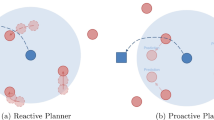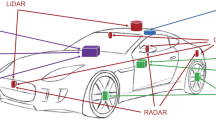Abstract
Most of the current human-aware navigation methods of service robots focus on improving the reactive navigation of local path planning without considering the global environment. A global path planning method is proposed based on the global scope of pedestrian perception and multi-layer cost-maps. Firstly, personal space and group interaction are modeled as social cost based on pedestrian perception, and then multi-layer dynamic cost maps are generated containing the social cost at different time-steps based on pedestrian trajectory prediction, which provides social constraints for global path planning. Secondly, the global path planner searches for the optimal state with heuristic cost function based on the multi-layer dynamic cost-maps. Considering the huge calculation of heuristic search and the limitation of the length of trajectory prediction duration, the ‘plan-prediction-execution’ cycle is introduced for the dynamic planning, which improves performance in the dynamic environment. Finally, compared with the traditional path planner in the simulation scenes including pedestrian movements and group interaction, the experimental results show that the path length, the execution time is shorter, and the comfort distance of the person/group is more social in our method. Through the actual scene experiments, the advantages of handling situations of planning timeout and adjusting trajectories dynamically after introducing the ‘plan-prediction-execution’ cycle are verified, which can meet the comfort and society of human-aware navigation.








Similar content being viewed by others
References
Bai, H., Cai, S., Ye, N., Hsu, D., Lee, W.S.: Intention-aware online POMDP planning for autonomous driving in a crowd. In: 2015 IEEE international conference on robotics and automation (ICRA). Seattle, USA. IEEE, pp. 454–460 (2015)
Chen, Y.F., Everett, M., Liu, M.: How, Socially aware motion planning with deep reinforcement learning. In: 2017 IEEE/RSJ international conference on intelligent robots and systems (IROS). Vancouver, Canada, IEEE, pp. 1343–1350
Escobedo, A., Spalanzani, A., Laugier, C.: Using social cues to estimate possible destinations when driving a robotic wheelchair. In: 2014 IEEE/RSJ International conference on intelligent robots and systems. Chicago, USA: IEEE, pp. 3299–3304 (2014)
Ferrer, G., Sanfeliu, A.: Proactive kinodynamic planning using the extended social force model and human motion prediction in urban environments. In: 2014 IEEE/RSJ International conference on intelligent robots and systems. Chicago, USA: IEEE, pp. 1730–1735 (2014)
Ferrer, G., Sanfeliu, A.: Bayesian human motion intentionality prediction in urban environments. Pattern Recogn. Lett. 44, 134–140 (2014)
Fox, D., Burgard, W., Thrun, S.: The dynamic window approach to collision avoidance. IEEE Robot. Autom. Mag. 4(1), 23–33 (1997)
Gaydashenko, A.: A comparative evaluation of machine learning methods for robot navigation through human crowds. In: 2018 17th IEEE international conference on machine learning and applications. Orlando, USA. IEEE, pp. 553–557 (2018)
Hekmati, A., Gupta, K.: On safe robot navigation among humans as dynamic obstacles in unknown indoor environments. In: 2018 IEEE international conference on robotics and biomimetics. Kuala Lumpur, Malaysia. IEEE, pp. 1082–1087 (2018)
Jiang, L., Wang, W., Chen, Y., Jia, Y.: Personalize vison-based human following for mobile robots by learning from human-driven demonstrations. In: 2018 27th IEEE international symposium on robot and human interactive communication (RO-MAN). Nanjing, China, IEEE, pp. 726–731
Khambhaita, H., Alami, R.:. Assessing the social criteria for human-robot collaborative navigation: a comparison of human-aware navigation planners. In: 2017 26th IEEE international symposium on robot and human interactive communication (RO-MAN). Lisbon, Portugal, IEEE, pp. 1140–1145 (2017)
Kirby, R.: Social robot navigation. Carnegie Mellon University, Pittsburgh (2010)
Kretzschmar, H., Spies, M., Sprunk, C., Burgar, W.: Socially compliant mobile robot navigation via inverse reinforcement learning. Int. J. Robot. Res. 35(11), 1289–1307 (2016)
Kruse, T., Pandey, A.K., Alami, R., et al.: Human-aware robot navigation: a survey. Robot. Auton. Syst. 61(12), 1726–1743 (2013)
Lavalle, S., Kuffner, M.: Randomized kinodynamic planning. Int. J. Robot. Res. 20(5), 378–400 (2011)
Linder, T., Arras, K.O.: Multi-model hypothesis tracking of groups of people in RGB-D data. In: 17th international conference on information fusion (FUSION). Salamanca, Spain: IEEE, pp. 1–7 (2014)
Lu, D. V., Hershberger, D., Smart, W. D.: Layered costmaps for context-sensitive navigation. In: 2014 IEEE/RSJ international conference on intelligent robots and systems. Chicago, USA: IEEE, pp. 709–715 (2014)
Mateus, A., Ribeiro, D., Miraldo, P., et al.: Efficient and robust pedestrian detection using deep learning for human-aware navigation. Robot. Auton. Syst. 113, 23–37 (2019)
Moussaïd, M., Perozo, N., Garnier, S., et al.: The walking behaviour of pedestrian social groups and its impact on crowd dynamics. PLoS One 5(4), e10047 (2010)
Park, C., Ondřej, J., Gilbert, M., et al.: HI robot: human intention-aware robot planning for safe and efficient navigation in crowds. In: 2016 IEEE/RSJ international conference on intelligent robots and systems. Daejeon, South Korea: IEEE, pp. 3320–326 (2016)
Pierson, A., Schwarting, W., Karaman, S., Rus, D.: Navigating congested environments with risk level sets. In: 2018 IEEE International conference on robotics and automation (ICRA). Brisbane, Australia: IEEE, pp. 1–8 (2018)
Rios-Martinez, J., Spalanzani, A., Laugier, C.: From proxemics theory to socially-aware navigation: a survey. Int. J. Soc. Robot. 7(2), 137–153 (2015)
Rösmann C, Feiten W.: Trajectory modification considering dynamic constraints of autonomous robots. In: German Conference on Robotics (ROBOTIK), Munich, Germany, VDE (2012)
Truong, X.T., Ngo, T.D.: Dynamic social zone based mobile robot navigation for human comfortable safety in social environments. Int. J. Soc. Robot. 8(5), 663–684 (2016)
Truong, X.T., Ngo, T.D.: “To approach humans?”: a unified framework for approaching pose prediction and socially aware robot navigation. IEEE Trans. Cognit. Dev. Syst. 10(3), 557–572 (2017)
Yang, C.-T., Zhang, T., Chen, L.-P., Fu, L.-C.: Socially-aware navigation of omnidirectional mobile robot with extended social force model in multi-human environment. In: 2019 IEEE International conference on systems, man and cybernetics (SMC). Bari, Italy, IEEE, pp. 1962–1968 (2019)
Funding
This work is supported by National Natural Science Foundation (NNSF) of China under Grant 61573100, 61573101.
Author information
Authors and Affiliations
Corresponding author
Additional information
Publisher's Note
Springer Nature remains neutral with regard to jurisdictional claims in published maps and institutional affiliations.
Rights and permissions
About this article
Cite this article
Fang, F., Shi, M., Qian, K. et al. A human-aware navigation method for social robot based on multi-layer cost map. Int J Intell Robot Appl 4, 308–318 (2020). https://doi.org/10.1007/s41315-020-00125-4
Received:
Accepted:
Published:
Issue Date:
DOI: https://doi.org/10.1007/s41315-020-00125-4




